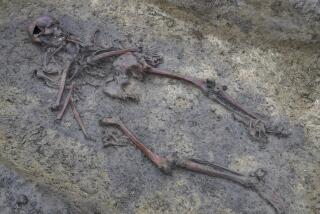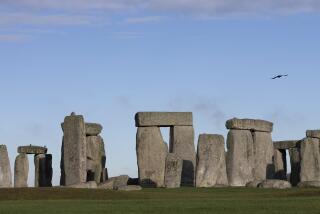Scientists see something royal in Stonehenge bones
- Share via
Radiocarbon dating of cremated bodies excavated from Britain’s Stonehenge appears to have solved part of the ancient mystery surrounding the 5,000-year-old site: It was a burial ground for what may have been the country’s first royal dynasty.
The new dates indicate burials began at least 500 years before the first massive stones were erected at the site and continued after it was completed, British archaeologists said Thursday .
The pattern and relatively small number of graves suggest all of the interred were members of a single family.
The findings provide the first substantive evidence that a line of kings ruled at least the lower portion of England during this early period, exerting enough power to mobilize the manpower necessary to move the massive stones from as far as 150 miles away and maintaining that power for at least five centuries, said archaeologist Mike Parker Pearson of the University of Sheffield, leader of the current excavations.
“It was clearly a special place at that time,” he said. “One has to assume that anyone buried there had some good credentials.”
Parker Pearson presented the new data at a teleconference organized by the National Geographic Society. It will also appear in the June issue of National Geographic magazine and in the television special “Stonehenge Decoded,” to be shown Sunday.
Stonehenge, on Salisbury Plain southwest of London, consists of concentric circles of massive stones -- some weighing as much as 50 tons -- surrounded by an earthen bank and a ditch.
Some of the stones were imported from Wales, about 150 miles away, and others were quarried about 20 miles away at Marlborough Downs. Construction began about 4,500 years ago, about the time the pharaohs were building the Great Pyramids of Giza.
The structure is aligned with sunrise at the summer solstice, and researchers have long viewed the monument as both an astronomical observatory and a cemetery, although they thought that the burials took place only over a relatively short period, perhaps a century.
But research over the last three years has provided a wealth of new information indicating that Stonehenge is only part of a much larger ceremonial and religious complex.
Excavations at Durrington Walls, two miles northeast of Stonehenge, revealed a village that is now thought to contain as many as 1,000 houses and a wooden henge that is virtually identical in design to Stonehenge but is aligned with sunrise at the winter solstice. It was built at the same time as Stonehenge.
Parker Pearson now believes that Stonehenge was the “Domain of the Dead,” where the ancient people, whose identity remains unknown, came together in somber ceremonies during summer to honor the dead.
Durrington Walls, in contrast, was the “Domain of the Living,” where raucous parties to celebrate life and fertility were held.
At the winter solstice, he said, people would gather again to inter their dead, perhaps flinging their ashes off a 12-foot cliff into the nearby River Avon.
The cremated remains dated by Parker Pearson’s team were excavated in the 1950s and have been stored in the nearby Salisbury Museum. Remains from an additional 49 burial sites were excavated in the 1920s but were reburied because researchers thought they were useless.
The remains had not been radiocarbon-dated until now because only recently has a new technique been devised for use on burned bones.
One set of remains, from the so-called Aubrey holes or pits surrounding Stonehenge, has been dated to 3030 BC to 2880 BC, about the time when the ditch and bank monument was first cut into Salisbury Plain.
A second, taken from the ditch surrounding Stonehenge, dates from 2930 BC to 2870 BC. A third, that of a woman about 25 years old, dates from 2570 BC to 2340 BC, the time when the first stones were being raised at the site.
Few objects were found with the remains, Parker Pearson said. One significant discovery, however, was a mace made of stone. Such maces have long been a symbol of authority in Britain, and even now Parliament has its own mace.
The team believes there are 150 to 240 burial sites scattered around Stonehenge, with the largest number dating from the last stages of the site’s use. Both the small number and its increase over the centuries -- as the number of offspring would have multiplied -- suggest that all came from a single family of rulers, said archaeologist Andrew Chamberlain of the University of Sheffield, a member of the current excavation team.
Other new evidence also suggests that the site was funereal in purpose. On the cliff overlooking the river, researchers have discovered a series of postholes that are architecturally the same as those found in the houses at Durrington Walls but much larger.
These poles, the team believes, supported elevated platforms where the dead were placed so their bones could be stripped of flesh by weathering, a practice that was common throughout much of the world.
Other new evidence involves the so-called cursus, a cigar-shaped enclosure near Stonehenge that is nearly two miles long. Discovered in the 1700s, it was originally thought to be a Roman-era racetrack.
But excavations last year revealed a red deer antler pick that was used for excavating the chalky soil. Radiocarbon dating indicates the pick was used around 3630 BC to 3375 BC, about 500 years before the first burials at Stonehenge and 1,000 years before the first stones were erected, said archaeologist Julian Thomas of the University of Manchester.
Researchers have never found artifacts or remains inside the cursus, which indicates it was walled. That suggests something sacred or evil was associated with the site, Thomas said.
“Sanctified or cursed? We really don’t know,” he said.
Pearson noted that henges are scattered throughout England, but Stonehenge is by far the most impressive. Later henges are much smaller, more suitable for an extended family than a royal dynasty, he noted.
There was an authority that was able to mobilize thousands of people to produce Stonehenge, he said, “but sometime around 2400 BC that authority broke down. Perhaps the people rebelled and decided they weren’t going to participate. There was a process of fragmentation” that continued until new dynasties were established three millenniums later.
--
More to Read
Sign up for Essential California
The most important California stories and recommendations in your inbox every morning.
You may occasionally receive promotional content from the Los Angeles Times.










